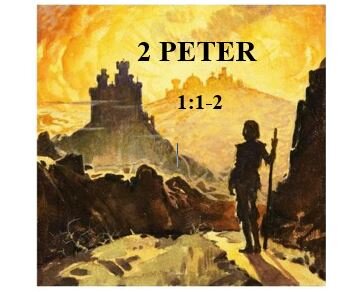BIG IDEA:
TRUE APOSTOLIC SUCCESSION = THE FOUNDATION FOR GROWTH IN THE KNOWLEDGE OF GOD (AND DIVINE POWER FOR GODLINESS) REMAINS THE SAME (FOR US AS FOR THE APOSTLES)
INTRODUCTION:
Concept of The Peter Principle in business
Are we truly following in the apostolic tradition?
I. THE MODEL FOR GROWTH IN THE TRUE KNOWLEDGE OF OUR LORD JESUS CHRIST = SIMON PETER
A. Review His Humble Beginnings and Many Failures
– Unlearned Fisherman
– Bold and Impetuous
– Called by Jesus Christ
– Name Change — Christ saw his potential
– Leadership position among the apostles
– His confession of Christ
– His walking on water
– His presence at the Mount of Transfiguration
– His presence at the empty grave
– Denial of Christ under pressure
– Foundational role in the formation of the church
– “upon this rock I will build my church”
– keys of the kingdom
– Preaching in the Book of Acts
– Leader in the church at Jerusalem
– Confronted by Paul for his Hypocrisy and Legalism
– Roman Catholic elevation as the Initial Pope
Roper: “We are told four things in this introduction. First, we are told the author is Simon Peter. Simon was his Aramaic name; Peter was his Greek name. Both words mean essentially the same thing: rock. If Peter were living today we would probably call him Rocky. He has the same endearing qualities as the hero in the movie ‘Rocky’ -a sort of rough exterior, and yet, I think, inside, a sensitive heart. He was a man who, outwardly, acted indifferently-he seemed to be very calloused at times, not too
sensitive to people’s needs-yet inside he had a very soft heart toward the Lord’s things, and a desire to be what God intended him to be. By the time he wrote this book he was an old man, probably in his seventies. He was one of the apostles, one of the twelve the Lord called into a relationship with him. After the Lord’s resurrection Peter was in Jerusalem for a time preaching, and, as a result of the persecution that broke out after the stoning of Stephen, he traveled to the north and settled in what today is Turkey – There he planted churches and ministered to the body of Christ. Shortly after
Paul’s death, he went to Rome. It was there that he lost his life, probably within a year of writing this letter. In fact, he may have been in prison at the time he wrote it, and he certainly was facing death, as he indicates in this book. As far as we know from tradition, Peter was crucified upside down outside the city of Rome, on the Ostian Way.”
B. Peter as a Bond-Servant of Jesus Christ
“Simon Peter, a bond-servant”
Mounce: “Doulos was a title of honor. Moses was a ‘servant of the Lord’ (Deut. 34:12), as were Joshua, David, Paul, and James. Both the prophets of the old dispensations (Amos 3:7) and those of the new (Acts 2:18) are called servants of God. While being a servant of God involves unquestioning obedience, the context is one of privilege rather than oppression.”
C. Peter as an Apostle of Jesus Christ
“and apostle of Jesus Christ”
II. THE ACTIVE INGREDIENT INSURING GROWTH =
THE SAME GIFT OF FAITH THAT STIRRED UP GROWTH AND FRUITFULNESS IN THE LIVES OF PETER AND THE OTHER APOSTLES
“to those who have received a faith of the same kind as ours”
Emphasis on the Sovereign Choice of God
Piper: “No matter how much authority a believer is given by Christ, he should never forget that the great joy of his life should simply be that he is saved by faith like all the other saints…
Three things in this second half of verse 1 emphasize the spiritual equality of all believers before God. First, the phrase ‘a faith of equal standing’ or ‘like precious faith.’ Second, the word ‘obtained’: ‘to those who have obtained a faith of equal standing.’ It is used only three other times in the New Testament and in each case refers to obtaining something not by effort or desert but by lot (Luke 1:9; John 19:24; Acts 1:17). So the very word Peter chooses illustrates how futile it would be for any of us to boast in our faith. It came to us by God’s choice, not by our prior effort. Then the third way of emphasizing the quality of believers in faith is to point out that what gives our faith value and distinction is Christ’s righteousness, not ours. It says we have faith ‘in (or by) the righteousness of our God and Saviour Jesus Christ.’ The phrase may mean that our faith came ‘by his righteousness’ (as the means), or that our faith is ‘in his righteousness’ (as the object). In both cases the effect is to stress that Christ’s unswerving faithfulness to do right is what we depend on, not our own righteousness. Therefore, we do not boast in our faith, for we ‘obtained’ it as a gift and its foundation is not our righteousness but Christ’s who is our God and Savior.”
III. THE GROUNDS FOR GROWTH = THE RIGHTEOUSNESS OF OUR GOD AND SAVIOR, JESUS CHRIST
“by the righteousness of our God and Savior, Jesus Christ.”
IV. THE RESOURCES FOR GROWTH IN THE TRUE KNOWLEDGE OF CHRIST = LARGE MEASURES OF GRACE AND PEACE
“Grace and peace be multiplied to you in the knowledge of God and of Jesus our Lord.”
Piper: ” If you want to enjoy God’s peace and be the aroma of his grace in the world, your knowledge of him has to grow. Grace is not a mere deposit. It is a power that leads to godliness and eternal life. And where knowledge of the glory and excellence of God languishes, grace does not flow. The channel from God’s infinite reservoir of grace into and through our lives is knowledge of God.”

